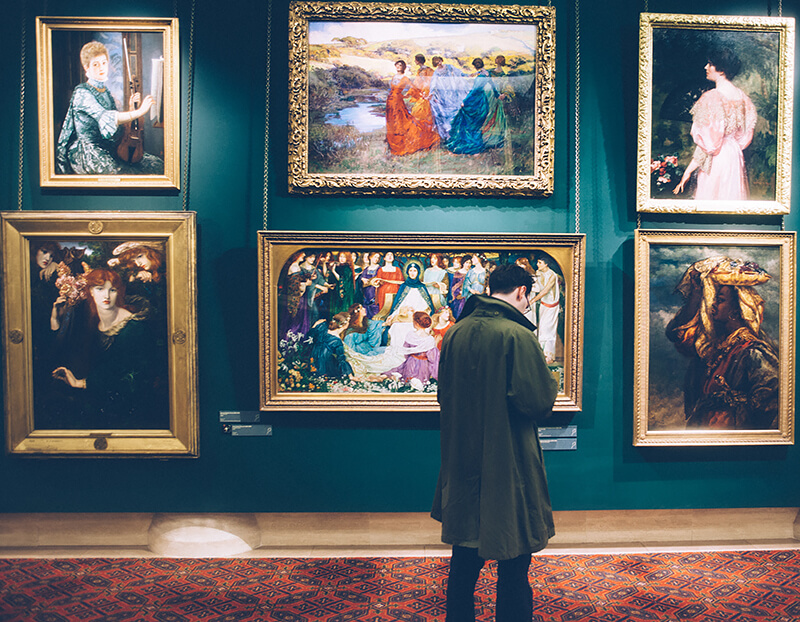Historical Context of Minimalist Color Use
Minimalist color use in contemporary art stems from early 20th-century movements like Suprematism and Constructivism. Artists like Malevich and Rodchenko embraced simplicity, challenging traditional art expectations.
In the 1960s, American artists Frank Stella and Donald Judd became prominent figures in minimalism. Stella's Black Paintings, showcased at the Museum of Modern Art in 1959, exemplified this shift with stark black bands on canvas. Judd focused on how art interacts with space, emphasizing physical presence over emotional storytelling.
These pioneers transformed art into a pure aesthetic experience, creating a new visual language. Their approach influenced contemporary artists who continue to explore minimalism, from Sol LeWitt's geometric works to Robert Ryman's vibrant monochromes.
Minimalism challenged viewers to reconsider the essence of art, igniting a movement that still resonates in modern galleries today.
Techniques and Materials in Minimalist Art
Minimalist artists embrace industrial materials, geometric shapes, and limited color palettes to redefine art perception and interaction. Their choices create a thoughtful dialogue between artwork and space.
Dan Flavin revolutionized minimalist art by using fluorescent lighting tubes as his primary medium. His installations emit monochrome light, reshaping spaces and inviting viewers to experience a play of light and form. Flavin's work focused on the sensory experience, using geometric light bursts to engage with interior architecture.
Robert Ryman explored the possibilities of the monochrome, particularly white. He transformed it into a tool to expose material qualities, dismissing symbolic color interpretations. Ryman's canvases featured visible brushstrokes or spare surfaces, emphasizing how art physically inhabits space.
Both artists pursued minimalism through distinct approaches:
- Flavin manipulated artificial light to reveal perceptions of color and space
- Ryman methodically examined painting's core components through his restrained palette and texture explorations
Minimalism asks us to focus on what remains when excess is removed. It allows materials' inherent qualities to speak, turning the mundane into something challenging. This ethos continues to guide contemporary artists exploring the potential within restraint.
Contemporary Artists and Minimalist Color
Contemporary artists Cat Spilman and Thomas Stempel carry on the minimalist color tradition, evoking emotional responses through simplified palettes.
Cat Spilman uses a two-tone palette, drawing from her background as a Scenic Artist. She works with house paint to create intricate textures and patterns. Spilman's art explores themes of:
- Separation
- Belonging
- Feminism
- Motherhood
By limiting her palette, she invites viewers to focus on the thematic core of her work.
Thomas Stempel's minimalist approach is inspired by Southern German landscapes and urban structures. Using a highly limited palette of one or two colors, he emphasizes shape and form. Stempel's precise hand-drawn techniques with pen and compass create artworks that are both static and dynamic, evoking personal memories and familiar objects through abstraction.
Both artists demonstrate that art doesn't need complexity to communicate meaning or emotion. They maintain a dialogue with minimalist pioneers while infusing contemporary sensibilities, showcasing minimalism's enduring relevance in art's evolving conversation.
Emotional and Aesthetic Impact of Minimalist Color
Minimalist color use in art evokes complex emotions through simplicity. This approach invites viewers into a conversation of introspection, where less becomes more.
Robert Ryman's white paintings challenge perceptions of emptiness, engaging viewers on a tactile level. Observers notice subtle variations in texture and the interplay of form and shadow, transforming simplicity into a nuanced emotional interaction.
Cat Spilman's dual-tone palette communicates vivid stories despite its stark appearance. Her work draws viewers to the energies expressed through color choices, amplifying emotional depth without overwhelming distractions.
Thomas Stempel's austere compositions bridge the natural and geometric, reflecting internal states and memories. His work acts as a mirror, allowing viewers to find personal resonance in abstraction.
Minimalist color use transforms simplicity into a potent canvas of emotional potential. It invites viewers to become co-creators of meaning, deepening their connection with art through personal interpretations. This approach reminds us that within simplicity lies a universe of unexplored perceptions, guiding us through new depths of feeling.
Minimalist color use in art challenges us to engage with artwork on a deeper level. By focusing on essentials, artists open up new avenues for personal reflection and emotional connection, transforming our perception of art's possibilities.
- Gray C. The Great Experiment in Art: 1863-1922. Thames & Hudson; 1962.
- Stella F. Working Space. Harvard University Press; 1986.























